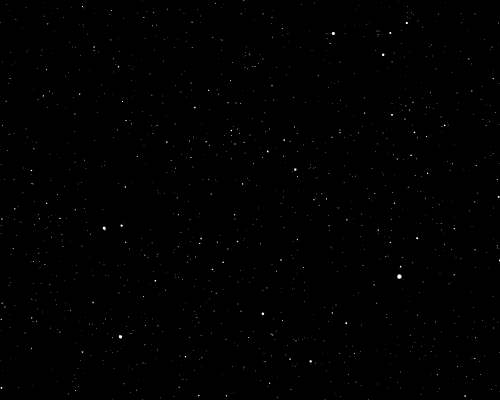File:StarfieldSimulation.gif
StarfieldSimulation.gif (500 × 400像素,文件大小:781 KB,MIME类型:image/gif、循环、240帧、7.2秒)
摘要
| 描述StarfieldSimulation.gif |
English: Inspired by the "Starfield Simulation" Screensaver for Windows. (With more stars in the distance.)
Deutsch: Ähnlich zum "Starfield Simulation" Bildschirmschoner von Windows. (Mit mehr Sternen in weiter Entfernung.) |
| 日期 | |
| 来源 | 自己的作品 |
| 作者 | Jahobr |
| 其他版本 |
|
| GIF开发 InfoField | |
| 源代码 InfoField | MATLAB codefunction StarfieldSimulation
% Source code that produces a GIF.
% Inspired by the "Starfield Simulation" Screensaver for Windows.
%
% 2017-04-20 Jahobr (update 2019-02-07 Jahobr)
[pathstr,fname] = fileparts(which(mfilename)); % save files under the same name and at file location
uniqueDepth = 200;
nFrames = 240;
renderDist = 200; % should be smaller or equal then uniqueDepth
StarDensity = 0.0005;
imageMax = [400, 500]; % pixel (height width)
subsampPix = 10; % subsampling per pixel in x and y
starRenderLimInPixel = 0.4; % diameter at least a x% of a pixel % if too small it flickers
for currentCase = 1:2
rng(1); % int rand generator to make GIF repeatable; If you dont like the GIF try a differnt value
speed = uniqueDepth/nFrames;
nStars = StarDensity*(2*renderDist * 2*renderDist * uniqueDepth);
x0 = rand(1,nStars)*renderDist*2-renderDist;
y0 = rand(1,nStars)*renderDist*2-renderDist;
sizze = 60+rand(1,nStars)*60;
sizze = [sizze sizze]; % copy space behind each other to loop the gif
depth = rand(1,nStars)*uniqueDepth;
depth = sort(depth); % makes later rendering more efficient
depth = [depth depth+uniqueDepth]; % copy space behind each other to loop the gif
switch currentCase
case 1 % classic
saveName = fname;
x_y = [x0 x0;y0 y0]; % copy space behind each other to loop the gif
thetaList = zeros(1,nFrames); % rotation
case 2 % rot 90° per gif loop
saveName = [fname '_rot'];
x_y = [x0 y0;y0 -x0]; % copy space behind each other to loop the gif
thetaList = linspace(0,pi/2,nFrames+1); % rotation
thetaList = thetaList(1:nFrames);
end
rawImage.cdata = uint8(zeros([imageMax 3]));
rawImage.colormap = [];
tic
for iFrame = 1:nFrames
disp([num2str(iFrame) ' of ' num2str(nFrames)])
image = zeros(imageMax);
%% calculate perspective
theta = thetaList(iFrame);
R = [cos(theta) -sin(theta);
sin(theta) cos(theta)];
x_y_rot = R * x_y; % rotate
plotImCoordX = (x_y_rot(1,:)./depth*imageMax(2))+imageMax(2)/2; % plane of view at depth 1; focal point at [0 0 0]
plotImCoordY = (x_y_rot(2,:)./depth*imageMax(1))+imageMax(1)/2; % plane of view at depth 1; focal point at [0 0 0]
distEuclid = sqrt( x_y_rot(1,:).^2 + x_y_rot(2,:).^2 + depth.^2 );% euclidean distance focal point at [0 0 0]
%% Rendering
% It could be done with figure and plot functions but they are not
% designed to display objects on the pixel and sub-pixel scale.
% The result just looks bad.
% So a own small rendering engine is used:
% check if a particular star rendering is necessary
% lay a grid over the star
% find if grid-points are within the star circle
% if yes, match the grid-point to a pixel and add its portion of
% "brightness" to the image
startIndex = find(depth>0,1,'first'); % depth was sorted
stopIndex = find(depth<renderDist,1,'last'); % depth was sorted
for k = startIndex:stopIndex % for all stars that would be in range
radiusStar = sizze(k)/distEuclid(k)/2;
if plotImCoordX(k)+radiusStar < 0 % outside to the left
continue % next star
end
if plotImCoordX(k)-radiusStar > imageMax(2)+1 % outside to the right
continue % next star
end
if plotImCoordY(k)+radiusStar < 0 % outside to the bottom
continue % next star
end
if plotImCoordY(k)-radiusStar > imageMax(1)+1 % outside to the top
continue % next star
end
if radiusStar*2>starRenderLimInPixel % diameter at least a defined part of a pixel
window = ceil(radiusStar *subsampPix); % size of grid to map over stars
inCircle = false(2*window,2*window);
for ix = 1:window % grid-points in positive x
for iy = 1:window % grid-points in positive y
distEuclidPixel = sqrt( ((ix-0.5)/subsampPix).^2 + ((iy-0.5)/subsampPix).^2);% euclidian distance focal point at [0 0 0]
% do a quarter of the circle and flip to -x,y and -x,-y and x,-y (1/8 would be enough actually)
if radiusStar>distEuclidPixel % is grid in reach of star
inCircle(window+ix ,window+iy ) = true; % 1 quadrant
inCircle(window+ix ,window+1-iy) = true; % 2 quadrant
inCircle(window+1-ix,window+iy ) = true; % 3 quadrant
inCircle(window+1-ix,window+1-iy) = true; % 4 quadrant
end
end
end
xGrid = round((( (1:2*window)-0.5-window) /subsampPix)+plotImCoordX(k)); % create x-grid and round to nearest Image pixel
yGrid = round((( (1:2*window)-0.5-window) /subsampPix)+plotImCoordY(k)); % create y-grid and round to nearest Image pixel
for ix = 1:2*window % pixel grid in x
if and(xGrid(ix) >= 1, xGrid(ix) <= imageMax(2)) % if in image
for iy = 1:2*window % pixel grid in y
if and(yGrid(iy) >= 1, yGrid(iy) <= imageMax(1)) % if in image
if inCircle(ix,iy) % if in Circle
image(yGrid(iy),xGrid(ix)) = image(yGrid(iy),xGrid(ix))+1/subsampPix^2; % add brightness to pixel
end
end
end
end
end
end
end
image(image>1) = 1; % fix "over exposure"
depth = depth-speed; % move
%% save animation
f = rawImage;
f.cdata(:,:,1) = uint8(image*255);
f.cdata(:,:,2) = uint8(image*255);
f.cdata(:,:,3) = uint8(image*255);
map = gray(8); % self created map. Otherwise use; [im,map] = rgb2ind(f.cdata,4,'nodither')
imtemp = rgb2ind(f.cdata,map,'nodither');
im(:,:,1,iFrame) = imtemp;
if iFrame == 1
im(1,1,1,nFrames) = 0; % allocate
end
end
toc
imwrite(im,map,fullfile(pathstr, [saveName '.gif']),'DelayTime',1/30,'LoopCount',inf) %
disp([saveName '.gif has ' num2str(numel(im)/10^6 ,4) ' Megapixels']) % Category:Animated GIF files exceeding the 50 MP limit
end
rng('shuffle'); % reset rand
|
许可协议
我,本作品著作权人,特此采用以下许可协议发表本作品:
| 本作品采用知识共享CC0 1.0 通用公有领域贡献许可协议授权。 | |
| 采用本宣告发表本作品的人,已在法律允许的范围内,通过在全世界放弃其对本作品拥有的著作权法规定的所有权利(包括所有相关权利),将本作品贡献至公有领域。您可以复制、修改、传播和表演本作品,将其用于商业目的,无需要求授权。
http://creativecommons.org/publicdomain/zero/1.0/deed.enCC0Creative Commons Zero, Public Domain Dedicationfalsefalse |
说明
添加一行文字以描述该文件所表现的内容
此文件中描述的项目
描繪內容
20 4 2017
image/gif
文件历史
点击某个日期/时间查看对应时刻的文件。
| 日期/时间 | 缩略图 | 大小 | 用户 | 备注 | |
|---|---|---|---|---|---|
| 当前 | 2017年4月20日 (四) 11:08 |  | 500 × 400(781 KB) | Jahobr | {{Information |Description ={{en|1=Inpired by the "Starfield Simulation" Screensaver for Windows. (With more stars in the distance.)}} {{de|1=Ählich zum "Starfield Simulation" Bildschirmschoner von Windows. (Mit mehr Sternen in weiter Entfernung)}}... |
文件用途
没有页面链接到本图像。
全域文件用途
以下其他wiki使用此文件:
- en.wikipedia.org上的用途



